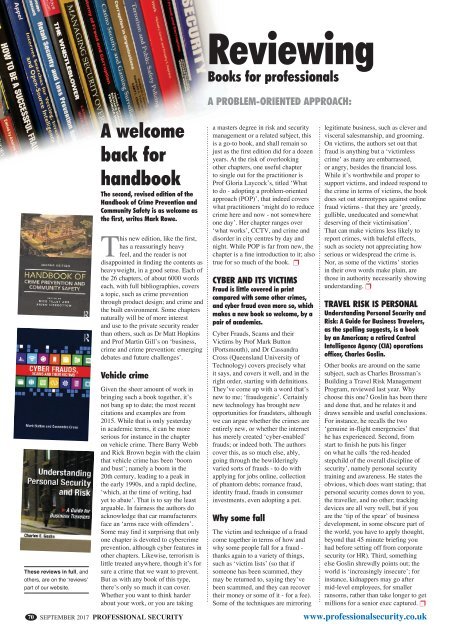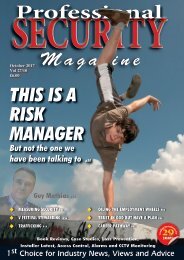You also want an ePaper? Increase the reach of your titles
YUMPU automatically turns print PDFs into web optimized ePapers that Google loves.
Reviewing<br />
Books for professionals<br />
A problem-oriented approach:<br />
These reviews in full, and<br />
others, are on the ‘reviews’<br />
part of our website.<br />
70<br />
A welcome<br />
back for<br />
handbook<br />
The second, revised edition of the<br />
Handbook of Crime Prevention and<br />
Community Safety is as welcome as<br />
the first, writes Mark Rowe.<br />
This new edition, like the first,<br />
has a reassuringly heavy<br />
feel, and the reader is not<br />
disappointed in finding the contents as<br />
heavyweight, in a good sense. Each of<br />
the 26 chapters, of about 6000 words<br />
each, with full bibliographies, covers<br />
a topic, such as crime prevention<br />
through product design; and crime and<br />
the built environment. Some chapters<br />
naturally will be of more interest<br />
and use to the private security reader<br />
than others, such as Dr Matt Hopkins<br />
and Prof Martin Gill’s on ‘business,<br />
crime and crime prevention: emerging<br />
debates and future challenges’.<br />
Vehicle crime<br />
Given the sheer amount of work in<br />
bringing such a book together, it’s<br />
not bang up to date; the most recent<br />
citations and examples are from<br />
2015. While that is only yesterday<br />
in academic terms, it can be more<br />
serious for instance in the chapter<br />
on vehicle crime. There Barry Webb<br />
and Rick Brown begin with the claim<br />
that vehicle crime has been ‘boom<br />
and bust’; namely a boom in the<br />
20th century, leading to a peak in<br />
the early 1990s, and a rapid decline,<br />
‘which, at the time of writing, had<br />
yet to abate’. That is to say the least<br />
arguable. In fairness the authors do<br />
acknowledge that car manufacturers<br />
face an ‘arms race with offenders’.<br />
Some may find it surprising that only<br />
one chapter is devoted to cybercrime<br />
prevention, although cyber features in<br />
other chapters. Likewise, terrorism is<br />
little treated anywhere, though it’s for<br />
sure a crime that we want to prevent.<br />
But as with any book of this type,<br />
there’s only so much it can cover.<br />
Whether you want to think harder<br />
about your work, or you are taking<br />
SEPTEMBER 2017 PROFESSIONAL SECURITY<br />
a masters degree in risk and security<br />
management or a related subject, this<br />
is a go-to book, and shall remain so<br />
just as the first edition did for a dozen<br />
years. At the risk of overlooking<br />
other chapters, one useful chapter<br />
to single out for the practitioner is<br />
Prof Gloria Laycock’s, titled ‘What<br />
to do - adopting a problem-oriented<br />
approach (POP)’, that indeed covers<br />
what practitioners ‘might do to reduce<br />
crime here and now - not somewhere<br />
one day’. Her chapter ranges over<br />
‘what works’, CCTV, and crime and<br />
disorder in city centres by day and<br />
night. While POP is far from new, the<br />
chapter is a fine introduction to it; also<br />
true for so much of the book. p<br />
CYBER AND ITS VICTIMS<br />
Fraud is little covered in print<br />
compared with some other crimes,<br />
and cyber fraud even more so, which<br />
makes a new book so welcome, by a<br />
pair of academics.<br />
Cyber Frauds, Scams and their<br />
Victims by Prof Mark Button<br />
(Portsmouth), and Dr Cassandra<br />
Cross (Queensland University of<br />
Technology) covers precisely what<br />
it says, and covers it well, and in the<br />
right order, starting with definitions.<br />
They’ve come up with a word that’s<br />
new to me; ‘fraudogenic’. Certainly<br />
new technology has brought new<br />
opportunities for fraudsters, although<br />
we can argue whether the crimes are<br />
entirely new, or whether the internet<br />
has merely created ‘cyber-enabled’<br />
frauds; or indeed both. The authors<br />
cover this, as so much else, ably,<br />
going through the bewilderingly<br />
varied sorts of frauds - to do with<br />
applying for jobs online, collection<br />
of phantom debts; romance fraud,<br />
identity fraud, frauds in consumer<br />
investments, even adopting a pet.<br />
Why some fall<br />
The victim and technique of a fraud<br />
come together in terms of how and<br />
why some people fall for a fraud -<br />
thanks again to a variety of things,<br />
such as ‘victim lists’ (so that if<br />
someone has been scammed, they<br />
may be returned to, saying they’ve<br />
been scammed, and they can recover<br />
their money or some of it - for a fee).<br />
Some of the techniques are mirroring<br />
legitimate business, such as clever and<br />
visceral salesmanship, and grooming.<br />
On victims, the authors set out that<br />
fraud is anything but a ‘victimless<br />
crime’ as many are embarrassed,<br />
or angry, besides the financial loss.<br />
While it’s worthwhile and proper to<br />
support victims, and indeed respond to<br />
the crime in terms of victims, the book<br />
does set out stereotypes against online<br />
fraud victims - that they are ‘greedy,<br />
gullible, uneducated and somewhat<br />
deserving of their victimisation’.<br />
That can make victims less likely to<br />
report crimes, with baleful effects,<br />
such as society not appreciating how<br />
serious or widespread the crime is.<br />
Nor, as some of the victims’ stories<br />
in their own words make plain, are<br />
those in authority necessarily showing<br />
understanding. p<br />
TRAVEL RISK IS PERSONAL<br />
Understanding Personal Security and<br />
Risk: A Guide for Business Travelers,<br />
as the spelling suggests, is a book<br />
by an American; a retired Central<br />
Intelligence Agency (CIA) operations<br />
officer, Charles Goslin.<br />
Other books are around on the same<br />
subject, such as Charles Brossman’s<br />
Building a Travel Risk Management<br />
Program, reviewed last year. Why<br />
choose this one? Goslin has been there<br />
and done that, and he relates it and<br />
draws sensible and useful conclusions.<br />
For instance, he recalls the two<br />
‘genuine in-flight emergencies’ that<br />
he has experienced. Second, from<br />
start to finish he puts his finger<br />
on what he calls ‘the red-headed<br />
stepchild of the overall discipline of<br />
security’, namely personal security<br />
training and awareness. He states the<br />
obvious, which does want stating; that<br />
personal security comes down to you,<br />
the traveller, and no other; tracking<br />
devices are all very well, but if you<br />
are the ‘tip of the spear’ of business<br />
development, in some obscure part of<br />
the world, you have to apply thought,<br />
beyond that 45 minute briefing you<br />
had before setting off from corporate<br />
security (or HR). Third, something<br />
else Goslin shrewdly points out; the<br />
world is ‘increasingly insecure’; for<br />
instance, kidnappers may go after<br />
mid-level employees, for smaller<br />
ransoms, rather than take longer to get<br />
millions for a senior exec captured. p<br />
www.professionalsecurity.co.uk










